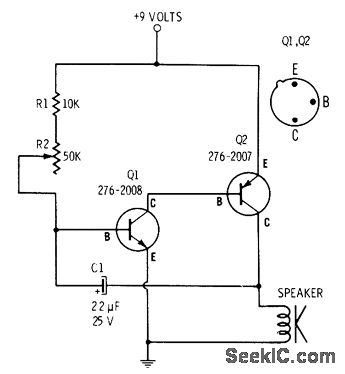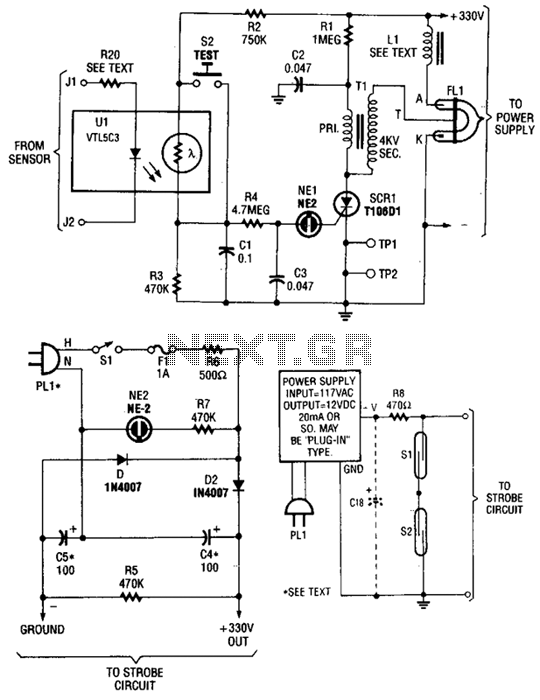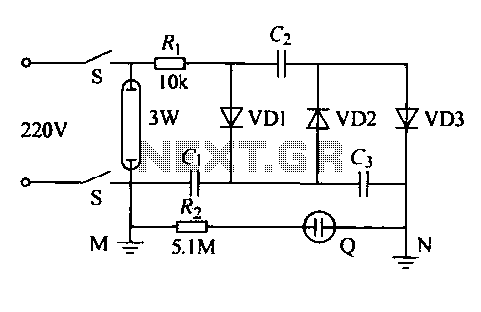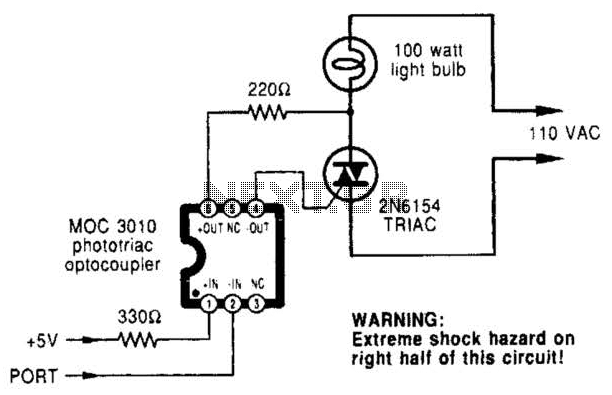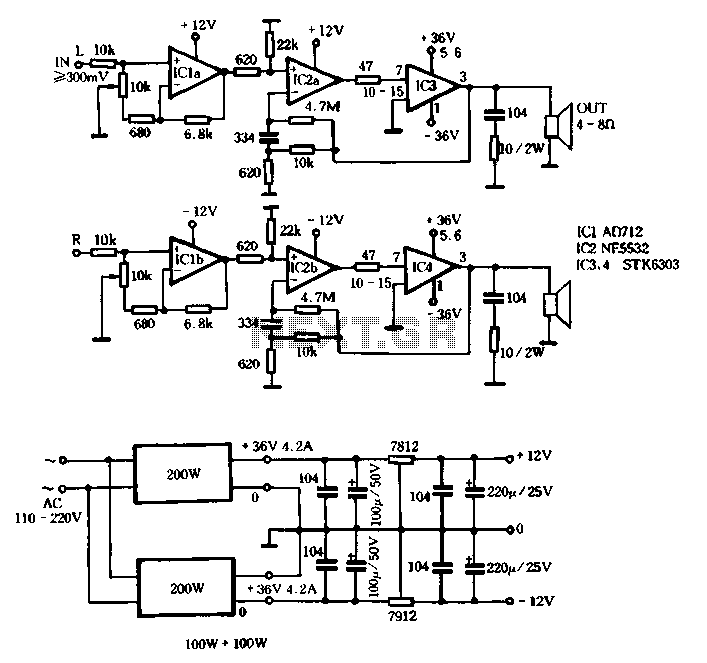
Common-emitter transistor amplifier quiescent bias circuit diagram
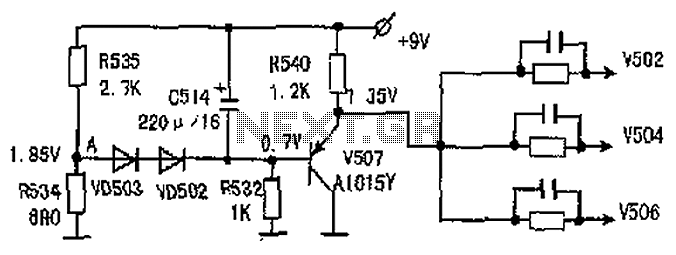
The common-emitter amplifier circuit V502, V504, V506 is designed to generate a static potential bias voltage through an emitter follower configuration, as illustrated in Figure 3. The active filter is formed by components V507, VD502, and VD503. The emitter static bias voltage follower circuit is comprised of resistors R534, R535, and capacitor C514. The resistor pair R535 and R534 creates a voltage divider that reduces the voltage from 1.85V to approximately 0.7V for the base of V507, VD502, and VD503, resulting in an emitter voltage of about 1.35V. The common-emitter amplifiers V502, V504, and V506 amplify this emitter bias voltage source. The common base amplifier's base bias voltage is directly sourced from the +9V power supply, and the base of the common base amplifier tube is AC grounded through capacitor C513. Consequently, the input and output signals for the common-base circuit are represented by V501, V503, and V505. The PNP transistor V507 serves as a common-emitter amplifier video amplifier with a quiescent bias in the emitter voltage follower. The video amplifier's common base amplifier tubes (V501, V503, V505) are connected to the +9V power supply. Fluctuations in the supply voltage can affect the quiescent operating point, leading to variations in the static potential at the collector, which in turn impacts screen brightness. To mitigate this, the circuit diagram ensures that the common-emitter amplifier's emitter follower bias voltage tracks changes in the +9V power supply synchronously. This design helps maintain emitter voltage stability for the common base transistors, ensuring that the collector static potential of V501, V503, and V505 remains unchanged despite supply voltage variations. This approach enhances product performance consistency in mass production and ensures that individual brightness levels are unaffected by minor supply voltage changes. The junction voltage of VD503 and VD502 (0.5-0.7V) decreases with temperature increases, allowing the emitter potential of V507 to rise, which compensates for the common-emitter video amplifier. The increased gain from the two cascaded common base transistors helps stabilize the static operating point, reducing drift in the final stage of the video amplifier and improving operational stability. Capacitor C514, connected between the +9V power supply and the base of V507, also serves to mitigate power transients that could cause luminance fluctuations.
The common-emitter amplifier circuit, featuring transistors V502, V504, and V506, operates by utilizing a voltage follower configuration that stabilizes the bias voltage at the emitter. This configuration is crucial for maintaining consistent performance in video applications where brightness levels must remain stable despite variations in supply voltage. The resistors R534 and R535 are integral to creating a reliable voltage divider, allowing for precise control of the base voltage applied to the transistors V507, VD502, and VD503. The careful selection of component values ensures that the total emitter voltage remains stable, even as the input voltage fluctuates.
The role of the common base amplifier is significant in this circuit, as it directly influences the overall gain and response of the amplifier. By grounding the base through capacitor C513, the circuit allows for AC signal coupling while maintaining a stable DC operating point. This ensures that the input signals processed through V501, V503, and V505 can be amplified effectively without introducing unwanted noise or distortion.
Temperature compensation is another critical aspect of this design. The junction voltages of the diodes VD502 and VD503 are sensitive to temperature changes, and their behavior is leveraged to adjust the biasing of the video amplifier. As the temperature rises and the junction voltage decreases, the circuit compensates by allowing the emitter voltage of V507 to increase, thereby maintaining the amplifier's performance.
In summary, the circuit's design is meticulously crafted to ensure operational stability and consistency in video amplification applications. By integrating various components such as voltage followers, common-emitter amplifiers, and temperature compensation mechanisms, the circuit achieves a robust performance that meets the demands of high-quality video signal processing. Common-emitter amplifier V502, V504, V506 emitter static potential bias voltage forming circuit [ie voltage follower) shown in Figure 3. Active filter by the V507, VD502, VD503 , R534, R535, C514, R540 is composed of V502, V504, V506 emitter static bias voltage follower circuit. R535, R534 composed divider network dividing point voltage by 1.85V down to V507 VD502 VD503 string base, about 0.7V, its emitter voltage of about 1.35V or so, as the common-emitter amplifier V502, V504, V506 three only enlarge the emitter bias voltage source tube.
Common base amplifier base bias voltage directly from + 9V power supply, common base amplifier tube base by C513 AC ground, and therefore input and output signals in terms of V501, V503, V505 for the common-base circuit. Using V507 (PNP-tube) as a common-emitter amplifier video amplifier quiescent bias in the emitter voltage follower, because the video amplifier common base amplifier tubes V501, V503, V505 are connected to the base of the power supply + 9V endpoint.
A slight change in the supply voltage, will affect its quiescent operating point, the output tube collector static potential changes affecting the brightness of the screen. For this reason, the use of the circuit diagram, so that common-emitter amplifier bias voltage emitter follower + 9V power supply trace changes synchronously change, that a slight change in the + 9V power supply, V502, V504, V506 emitter voltage follower change, to ensure total emitter, common base of two transistors are not fluctuate with changes in the power trace, ie V501, V503, V505 collector static potential unchanged.
This aspect can ensure consistency of product performance in large quantities, but also to ensure that single brightness is not affected by small changes in the supply voltage. VD503, VD502 junction voltage (0.5-0.7V) decreases with increasing temperature, so that V507 emitter potential rise can be compensated video amplifier common emitter, increased two cascaded amplifiers Shenlian common base transistor with increasing temperature, causing static IMPACT operating point changes, so that the final stage amplifier video amplifier drift is reduced, job stability is greatly improved.
Since the C514 is connected between the power supply + 9V and V507 base, but also to avoid power transients caused by luminance transients.
The common-emitter amplifier circuit, featuring transistors V502, V504, and V506, operates by utilizing a voltage follower configuration that stabilizes the bias voltage at the emitter. This configuration is crucial for maintaining consistent performance in video applications where brightness levels must remain stable despite variations in supply voltage. The resistors R534 and R535 are integral to creating a reliable voltage divider, allowing for precise control of the base voltage applied to the transistors V507, VD502, and VD503. The careful selection of component values ensures that the total emitter voltage remains stable, even as the input voltage fluctuates.
The role of the common base amplifier is significant in this circuit, as it directly influences the overall gain and response of the amplifier. By grounding the base through capacitor C513, the circuit allows for AC signal coupling while maintaining a stable DC operating point. This ensures that the input signals processed through V501, V503, and V505 can be amplified effectively without introducing unwanted noise or distortion.
Temperature compensation is another critical aspect of this design. The junction voltages of the diodes VD502 and VD503 are sensitive to temperature changes, and their behavior is leveraged to adjust the biasing of the video amplifier. As the temperature rises and the junction voltage decreases, the circuit compensates by allowing the emitter voltage of V507 to increase, thereby maintaining the amplifier's performance.
In summary, the circuit's design is meticulously crafted to ensure operational stability and consistency in video amplification applications. By integrating various components such as voltage followers, common-emitter amplifiers, and temperature compensation mechanisms, the circuit achieves a robust performance that meets the demands of high-quality video signal processing. Common-emitter amplifier V502, V504, V506 emitter static potential bias voltage forming circuit [ie voltage follower) shown in Figure 3. Active filter by the V507, VD502, VD503 , R534, R535, C514, R540 is composed of V502, V504, V506 emitter static bias voltage follower circuit. R535, R534 composed divider network dividing point voltage by 1.85V down to V507 VD502 VD503 string base, about 0.7V, its emitter voltage of about 1.35V or so, as the common-emitter amplifier V502, V504, V506 three only enlarge the emitter bias voltage source tube.
Common base amplifier base bias voltage directly from + 9V power supply, common base amplifier tube base by C513 AC ground, and therefore input and output signals in terms of V501, V503, V505 for the common-base circuit. Using V507 (PNP-tube) as a common-emitter amplifier video amplifier quiescent bias in the emitter voltage follower, because the video amplifier common base amplifier tubes V501, V503, V505 are connected to the base of the power supply + 9V endpoint.
A slight change in the supply voltage, will affect its quiescent operating point, the output tube collector static potential changes affecting the brightness of the screen. For this reason, the use of the circuit diagram, so that common-emitter amplifier bias voltage emitter follower + 9V power supply trace changes synchronously change, that a slight change in the + 9V power supply, V502, V504, V506 emitter voltage follower change, to ensure total emitter, common base of two transistors are not fluctuate with changes in the power trace, ie V501, V503, V505 collector static potential unchanged.
This aspect can ensure consistency of product performance in large quantities, but also to ensure that single brightness is not affected by small changes in the supply voltage. VD503, VD502 junction voltage (0.5-0.7V) decreases with increasing temperature, so that V507 emitter potential rise can be compensated video amplifier common emitter, increased two cascaded amplifiers Shenlian common base transistor with increasing temperature, causing static IMPACT operating point changes, so that the final stage amplifier video amplifier drift is reduced, job stability is greatly improved.
Since the C514 is connected between the power supply + 9V and V507 base, but also to avoid power transients caused by luminance transients.
Warning: include(partials/cookie-banner.php): Failed to open stream: Permission denied in /var/www/html/nextgr/view-circuit.php on line 713
Warning: include(): Failed opening 'partials/cookie-banner.php' for inclusion (include_path='.:/usr/share/php') in /var/www/html/nextgr/view-circuit.php on line 713
